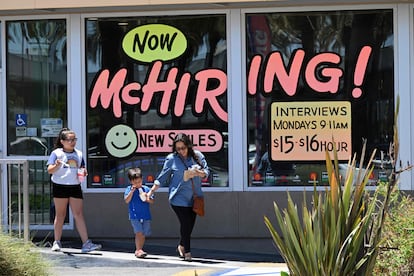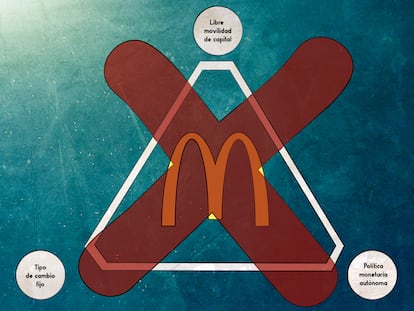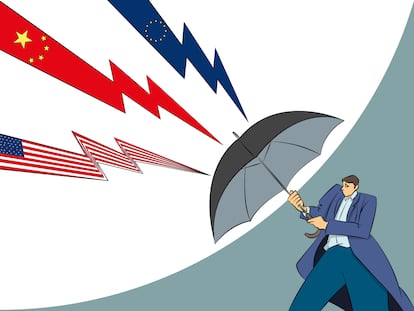‘Pain’ and ‘sacrifice’: In global fight against inflation, rhetoric provides clues
Central banks are rolling out policies to cool the economy, but the usual tools will not work in this particular crisis

“Pain,” “sacrifice,” the “end of abundance.” For the flesh-and-blood economy, there is no better indicator of the upcoming crisis than the moralizing tone that is beginning to permeate global economic rhetoric.
Analysts traditionally look at industrial and freight traffic numbers as well as consumer confidence figures, among other data points, for early signs that something is wrong. This information is usually relevant, yet no index was able to detect the Great Recession of 2008 better and faster than the sobering advice about living beyond our means, not to mention all those recurring metaphors about dieting and taking our medicine.
US Federal Reserve Chairman Jerome Powell last week warned about “some pain” ahead for families and businesses in the fight against inflation. Isabel Schnabel, executive board member of the European Central Bank (ECB), recently pointed to the probable need for “sacrifice.” A day earlier, French President Emmanuel Macron had announced “the end of abundance.”
It is still unclear how serious the coming decline – fueled by soaring inflation, the energy crisis and the fear of recession – will be, but on both sides of the Atlantic that infallible indicator, language, is already moving into a higher gear.
“Nothing embittered the German people so much – it is important to remember this- nothing made them so furious with hate and so ripe for Hitler as inflation,” wrote the Austrian author Stefan Zweig in his famous 1942 memoir The World of Yesterday. Zweig remembered the hyperinflation of the Weimar Republic with astonishment, recounting how a family ended up needing millions of marks just to get through the day, could hardly find coal to heat themselves in winter, while the value of the mark sank and “vultures” with foreign currency hoarded everything in sight.
The soaring rise in prices, one of the economic trends most feared by governments, has now reached levels unseen in 40 years, and it is affecting a good portion of the world’s developed economies. Europe, the United States, Canada and the United Kingdom are now experiencing in excess or close to a double-digit inflation rate, when the orthodoxy indicates that it should hover around 2%. And the central banks, which determine monetary policy and have a mandate to control inflation, have sounded the alarm. In these situations, the handbook recommends raising interest rates, that is, making loans to companies and households more expensive, in order to reduce demand and rein in prices.
“Reducing inflation is likely to require a sustained period of below-trend growth... some softening of labor market conditions... [and] some pain to households and businesses,” warned the Fed chief on August 26, at the traditional monetary policy symposium held each year in Jackson Hole, Wyoming. “But a failure to restore price stability would mean far greater pain.”
There is at least one but and one question mark. The but is that, in this inflationary crisis, the strength of the labor market and the appetite for spending is only one of the causes, and not even the main one at that in the case of Europe. The energy crisis, the war in Ukraine and problems with supply chains have combined with a strong economy, and the usual toolbox of central bankers has no answer for that. And the question is how much of that “pain” that Powell mentioned is really required, and whether it is possible to proceed with the de-escalation without entering a recession or a long stagnation, in what the institution calls an “immaculate disinflation.”
Aggressiveness
History suggests that, most of the time, that soft landing does not happen. Alan Greenspan’s Fed did it in the 1990s, raising the price of money to 6%, but the rate of inflation was almost half what it is today and its motives less complex. In Washington and Frankfurt, the ghost of the 1970s is much more present these days. Back then, Fed Chairman Arthur Burns was complacent with high inflation and it lasted for a decade. It was Paul Volcker, considered the “patron saint” of the Fed, who solved the problem in the 1980s by pushing up the price of money up to 20%, albeit at the cost of two economic recessions. Inflation had climbed to 14% at that point.
What will happen this time around? Analyst Desmond Lachmand of the American Enterprise Institute, a conservative think tank in Washington, is quite critical. “Inflation will be brought under control, but there will be a cost, and it will be a recession. Central banks have no choice but to slow down the economy, but I think they are doing it too aggressively, at least at the Fed, and may cause a harder than necessary recession,” he says. “The mistake they made was not to act last year, when they were convinced that inflation was a transitory problem, and now they are going to pay the price,” he adds, then corrects himself: “Well, no: we are going to pay the price.”
The adjustment is already beginning to be felt at street level. In Europe, mortgages became more expensive in August, experiencing the fastest rise since 2000 due to the hike in the Euribor rate. This further pounds the pockets of citizens, who are paying much more for nearly everything, from gasoline to food to electricity bills. Meanwhile, Russia has just announced that it is cutting off its gas supply to Europe, and Germany, the area’s engine of growth, is going to feel it more intensely than most.
Many economists are assuming a recession is coming in the United Kingdom and the euro zone, but not because of the policies of central banks, but rather because of the cocktail made up of the energy crisis, inflation and doubts about the future. The tightening of monetary policy is just the icing on the cake.
In general, there is a consensus on the need to continue raising rates after more than a decade of strong monetary expansion and with inflation out of control. This would take advantage of the fact that the labor market is robust enough to handle the blow (employment rates are at all-time highs in the euro zone and there is full employment in the United States). The debate between the hawks (guardians of orthodoxy) and the doves (defenders of heterodoxy) lies in the speed of this adjustment, as reflected in the minutes of central bank meetings.
Isabel Schnabel, the ECB board member, said in Jackson Hole that there were two alternatives: act with prudence, since inflation is caused by external shocks and rates may not solve it, or proceed decisively even at the risk of lower growth and higher unemployment. She defended the second course of action.
High volatility
“May you live in interesting times” is supposedly a Chinese curse that is often mentioned when talking about monetary policy. These times are proving devilishly interesting for central bankers. They have not had to respond to an inflationary challenge like this in 40 years and they find themselves, moreover, in an unprecedented scenario that is putting their usual weapons to the test: job creation is more difficult to predict with the Covid pandemic, climate change has increased volatility in energy and food prices, and the protectionist shift caused by the coronavirus and geopolitical tensions is casting doubt on the stability of supply.
“The so-called divine coincidence, the principle according to which, if inflation stabilizes at the target, the optimum level of economic activity is also reached, no longer holds,” explains the economist Ángel Ubide. The three decades after the 1980s are known as the era of “Great Moderation” because of the relative smoothness of economic swings. Schnabel recently warned of the danger of entering an era of “Great Volatility” and highlighted the role that governments’ fiscal policy must play to prop up the economy against shocks.
The United States managed to ease inflation slightly in July and, at least until the Russian gas cutoff, there have been reasons to think that the trend will be replicated in Europe. But if a forceful slowdown in prices is not achieved due to energy and other external shocks and if, at the same time, economic activity enters a long period of lethargy, it could raise another specter: stagflation, or high inflation with low growth and job destruction.
“With the current level of inflation, an interest rate that is at least neutral [that controls inflation without weighing down growth] is necessary, the Fed already has it and the message from the ECB is moving in that direction,” says Ubide. The Governor of the Bank of France, Francois Villeroy de Galhau, believes that the ECB’s neutral rate lies between 1% and 2%. “The question is what happens next, if they are willing to continue rising rates to slow down the economy,” adds Ubide. The United States is having a somewhat easier time containing the escalation because its inflation is more closely linked to demand. The success of the central banks in this battle against inflation will be seen, says Ángel Ubide, “once the energy crisis is over.”
The International Monetary Fund (IMF)’s number two official, Gita Gopinath, issued a few recommendations last week: she warned that emergency aid should be directed to people in need to avoid turning it into a fiscal stimulus program, and she also urged leaders to take measures for the climate transition and policies that promote the diversification of global trade.
Philipp Heimberger, from the Institute for International Economic Studies in Vienna, stresses the loss of purchasing power that European workers are already accumulating. Wages have not kept pace with inflation, and he describes the central banks’ communication strategy, with its accent on sacrifice, as “terrible.” But there is nothing haphazard about such language, according to David Wilcox, an economist at the Peterson Institute for International Economics and at Bloomberg Economics. “Powell has wrapped himself in the robes of Volcker [the Fed chief who handled disinflation and the 1980s recessions] and said that he understands the responsibility to control inflation, and that he is determined to do it and will do whatever it takes,” he notes. The head of the ECB, Christine Lagarde, spoke in similar terms last June in Sintra, Portugal.
The wording is eerily reminiscent of the famous “Whatever it takes” uttered by Mario Draghi when he was the head of the ECB at the height of the euro crisis. Except this time the policy is moving in the opposite direction. The ECB is expected to provide more clues this week in Frankfurt. These are, the curse says, interesting times.
Tu suscripción se está usando en otro dispositivo
¿Quieres añadir otro usuario a tu suscripción?
Si continúas leyendo en este dispositivo, no se podrá leer en el otro.
FlechaTu suscripción se está usando en otro dispositivo y solo puedes acceder a EL PAÍS desde un dispositivo a la vez.
Si quieres compartir tu cuenta, cambia tu suscripción a la modalidad Premium, así podrás añadir otro usuario. Cada uno accederá con su propia cuenta de email, lo que os permitirá personalizar vuestra experiencia en EL PAÍS.
¿Tienes una suscripción de empresa? Accede aquí para contratar más cuentas.
En el caso de no saber quién está usando tu cuenta, te recomendamos cambiar tu contraseña aquí.
Si decides continuar compartiendo tu cuenta, este mensaje se mostrará en tu dispositivo y en el de la otra persona que está usando tu cuenta de forma indefinida, afectando a tu experiencia de lectura. Puedes consultar aquí los términos y condiciones de la suscripción digital.
More information
Últimas noticias
Most viewed
- Sinaloa Cartel war is taking its toll on Los Chapitos
- Oona Chaplin: ‘I told James Cameron that I was living in a treehouse and starting a permaculture project with a friend’
- Reinhard Genzel, Nobel laureate in physics: ‘One-minute videos will never give you the truth’
- Why the price of coffee has skyrocketed: from Brazilian plantations to specialty coffee houses
- Silver prices are going crazy: This is what’s fueling the rally











































